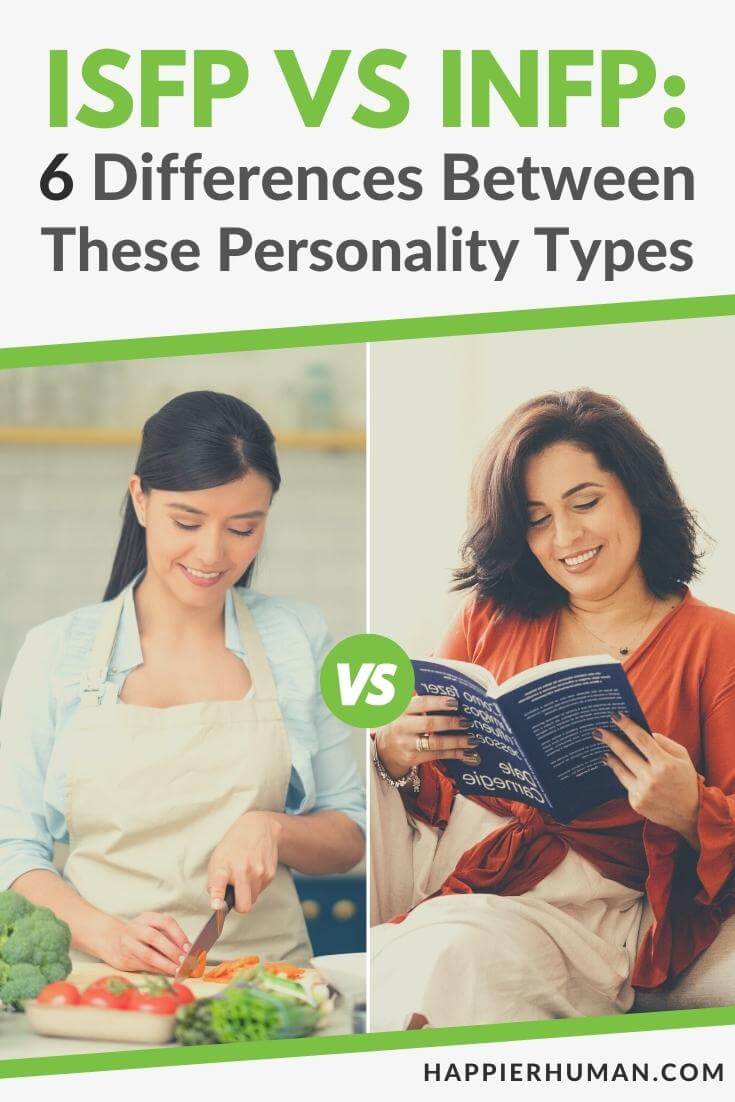The ISFP and INFP personalities are introverts but aren’t shy about it. These personality types are distinctive types that may be hard to get to know but create a lasting impression.
However, their specific attitudes and behaviors are highly different. Let’s learn more about ISFP and INFP personalities and their significant differences.
What Is the ISFP Personality Type?
The ISFP is known as the Artist or the Composer because their strong aesthetics and appreciation for beauty usually manifest tangibly in how they use tools and work with their hands. Key characteristics of this type are:
Introverted
The first preference indicates where people tend to direct and receive their energy. Introverts prefer to channel their energy inward toward ideas, information, and beliefs.
Introverts prefer doing things alone or with just one or two people they know and trust. Introverts usually think and plan before they act or speak and sometimes like the idea of something better than the thing itself.
Sensing
The second psychological preference indicates the way a person prefers to receive information. A sensing person pays attention to the information they receive through their five sense: taste, touch, smell, sight, and hearing.
They focus best on what is present, current, and real, noticing actual facts and remembering concrete details. They understand the practical use of things and learn through hands-on experience.
Feeling
The third preference indicates the way a person prefers to make decisions. A feeling person makes decisions by considering the perspectives and opinions of everyone involved and trying to create a harmonious outcome.
They want to deeply understand the feelings of the people around them and reach a peaceful resolution, knowing that no two situations will have the same solution because other people and different feelings will be involved.
Perceiving
The final preference indicator refers to how a person deals with the outside world. A perceiving person remains flexible and spontaneous, allowing events to unfold around them.
They want to understand, adapt, and interact with the world rather than structure and control it. As a result, they are casual about their activities, keep planning to a minimum, and keep their options open.

An ISFP is warm and kind, with the grounded practicality that makes them great caretakers. They are open-minded and flexible, enjoying new experiences and getting along well with others.
An ISFP is a doer who seeks direct experiences and self-expression through action and is not very interested in abstract concepts or ideas that don’t have practical results. Their focus on enjoying the present can hinder their ability to make and carry through on long-term goals and plans.
What Is the INFP Personality Type?
The INFP is known as the Mediator, powerfully motivated to help others. Their key characteristics are:
Introverted
The first preference indicates where people tend to direct and receive their energy. Introverts prefer to channel their energy inward toward ideas, information, and beliefs.
Introverts prefer doing things alone or with just one or two people they know and trust. Introverts usually think and plan before they act or speak and sometimes like the idea of something better than the thing itself.
INtuiting
The second psychological preference indicates the way a person prefers to receive information. An intuiting person pays more attention to information patterns, impressions, and underlying meaning.
They learn by thinking things through and exploring the implications of new information. They mentally explore symbols, theories, and abstractions and remember ideas and concepts better than factual details.
Feeling
The third preference indicates the way a person prefers to make decisions. A feeling person makes decisions by considering the perspectives and opinions of everyone involved and trying to create a harmonious outcome.
They want to deeply understand the feelings of the people around them and reach a peaceful resolution. They know that no two different situations will have the same solution because other people and different feelings will be involved.
Perceiving
The final preference indicator refers to how a person deals with the outside world. A perceiving person prefers to remain flexible and spontaneous, allowing events to unfold around them.
They want to understand, adapt, and interact with the world rather than structure and control it. Therefore, they are casual about their activities, keep planning to a minimum, and keep their options open.
This combination of preferences makes The Mediator deeply interested in improving the world. They want to understand themselves and others and find a sense of meaning and purpose in using their abilities to serve humanity and work for the welfare of others.
They are quiet and reserved and think deeply about feelings and concepts. They tend to ignore petty details and often delay making important decisions in case something new comes along. But on the other hand, they are sensitive, imaginative, open-minded, and filled with a sense of purpose.
What Do ISFP and INFP Personalities Have in Common?
ISFP and INFP personalities are highly similar. Here are the most significant factors that these two personality types have in common.
1. Curious and Open-Minded
ISFP and INFP personalities are interested in the world around them, with active, curious minds. They seek out the opinions, perspectives, and knowledge of others and welcome new information and new ideas.
2. Passionate and Enthusiastic
ISFP and INFP personality types are passionate and energetic, getting caught up in the people and causes they care about, and willing to work hard to make them successful. In addition, they are incredibly supportive and helpful and devoted to their goals and values.
3. People-Pleasers
ISFP and INFP personalities care about the feelings and opinions of others, and this is exacerbated by the fact that they are introverts who tend to connect deeply with only a few people.
This can make them extraordinarily conflict-avoidant and highly motivated to please others, even when neglecting their care. As a result, these types struggle to maintain healthy boundaries and engage in healthy conflict.
A fantastic example of the similarities between these two types is comparing famous ISFP Paul McCartney with famous INFP John Lennon. Both men are reserved, thoughtful, creative, and care deeply about the world around them.
However, as an ISFP, Paul is more grounded and realistic, while John was more abstract and idealistic. Yet, together, they changed the world forever.
6 Key Differences Between ISFP and INFP Personalities
Despite these strong similarities, there are several important differences in the ISFP vs. INFP personality. Here are the biggest contrasts to be aware of:
1. Personality Type Frequency
ISFP: 5-9% overall. INFP: 4-5% overall
In America, ISFPs are almost twice as common as INFPs. However, both personality types are slightly more common among women than men.
2. Practical vs. Impractical
Practical: ISFP. The ISFP focus on the real, tangible world in front of them makes them incredibly practical. They can be impatient with concepts and ideas that don’t apply to real-world situations and problems and are likely to solve problems by trying different solutions and seeing what works.
Impractical: INFP, The INFP personality type is more interested in concepts and ideas and works best with symbols and abstractions that can be disconnected from the real world. Many of their ideas lack attention to real-world facts and details and can often be impractical.
3. Present-Focused vs. Future-Focused
Present-Focused: ISFP. The attention to tangible real-world experiences also makes the ISFP very focused on the present moment here and now.
They sincerely appreciate the sights, sounds, and sensations of the present moment, paying attention to nature, life, and their immediate surroundings. They tend to be more interested in short-term enjoyment than long-term goals.
Future-Focused: INFP. The INFP tends to be more focused on long-term goals and objectives and is willing to have unpleasant experiences at the moment if they think there will be a payoff at a later date. Their more abstract, cerebral thinking style doesn’t focus as much on what’s immediately around them but is more concerned with an imaginary future.
4. Doers vs. Thinkers
Doers: ISFP. The ISFP is an active doer who chooses activities that engage their senses. They are more likely to be making something with their hands, participating in physical activity or exercise, or creating something they can enjoy with their senses (like cooking or composing) than they are to enjoy more abstract, meditative activities like reading.

As introverts, they are happy to do these things alone, but they do like to be doing something.
Thinkers: INFP. An INFP is happy to get lost in thought and caught up in their imagination. Concepts, ideas, and symbols are real, so they don’t require as much input from their senses. They tend to enjoy reading, quiet talking, or just hanging out.
5. Appearance vs. Minimalism
Aesthetics: ISFP. The ISFP focus on enjoying the present moment gives them a natural gift for aesthetics. They want environments and situations that are enjoyable to their senses and create beauty all around them.
This sense of beauty and aesthetics, combined with their desire for hands-on activity, makes these personalities excellent artists and musicians.
Minimalism: INFP. An INFP isn’t as focused on the appearances of things and, in fact, often overlooks immediate sensory input because they are caught up in their ideas. Their environment usually doesn’t matter much to them, and they seldom spend a lot of effort on seeking beauty for its own sake.
6. Capricious vs. Devoted
Capricious: ISFP. An ISFP is likely to seek new sensations and experiences and, as such, can be a bit capricious, losing interest in activities and getting bored quickly. On the other hand, they dislike repetition and monotony, and their curiosity and present focus often prompt them to find new and different activities.
They will stick with projects and activities that deeply engage with their sense of purpose, but they can be flighty until or unless they find that purpose.
Devoted: INFP. An INFP is more likely to devote themselves to a project, goal, cause, or activity and stick with it for the long term. Their future focus and ability to overlook the present moment allow them to pursue their goals with greater consistency and devotion.
Final Thoughts on ISFP and INFP Personalities
As with Lennon and McCartney, ISFP and INFP personalities are highly compatible and likely to make excellent partners. Both personality types need and want the same things from life, so they can partner and work together toward shared goals.
However, since they are both perceivers, both personalities struggle with making plans and schedules and sticking with agendas, which can exacerbate some of their weaknesses and reduce conflict between these peace-loving personalities.
Knowing your MBTI personality type and the personality types of the people close to you can help you better understand yourself and others, ease communication and reduce conflict. If you are new to the world of personality types, check out our beginner’s guide to the 16 personalities and use this new knowledge in your everyday life.
Finally, if you want to identify YOUR personality type, then take one of these 11 personality tests to better understand what makes you tick.


